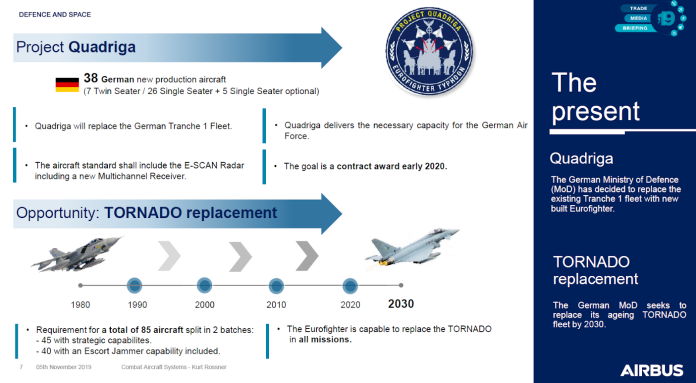The Halcón project (Falcon in English) is now a reality. NATO Eurofighter 2000 and Tornado Management Agency (NETMA) signed a contract during the ILA exhibition in Berlin to acquire 20 new Eurofighter combat aircraft intended for the Ejército del Aire in Spain. This contract is regarding Sixteen single-seater and four two-seater aircraft, all delivered from 2026 in the latest configuration of the European multirole fighter (Tranche 4 “Quadriga “) and in particular with an E-Scan active antenna radar.
Once inducted, Spain will have 90 Eurofighters (denomination C.16 within the Ejército del Aire). It will thus be able to retire its F-18s based in the Canary Islands (46th Wing in Gando, on the Grande Canary).
Madrid had authorized the acquisition of 20 new Airbus DS fighters last December, a contract valued at 2.043 billion euros (with associated engines, a simulator and support equipment).
The Spanish government had come out in favour of the purchase of new Eurofighters a few months earlier, wishing to deny rumours of the acquisition of F-35s, particularly for the replacement of the AV-8B Harrier II of the Spanish Armada. As a reminder, Spain is also in the process of modernizing its fleet of Eurofighters (3 sections) in the same way as those in Great Britain, Italy and Germany.
Project Halcón
In July 2020, Airbus Defense approached the Government of Spain with a proposal, under the name Project Halcón, to replace the ageing Hornets that operate from the very strategic Gando air base (off the coast of Morocco and Western Sahara) by Eurofighter.
Specifically, the proposal is for 20 EF-2000 Eurofighters, from a Tranche 3+ or 4, for around €2 billion. Airbus is offering to Spain similar to the German Quadriga Project (for 38 aircraft to replace the German Tranche 1).
Once delivered, these 20 aircraft will be the most modern and capable fighters of the Spanish Air Force (EdA). Like the German Typhoon, they will come equipped with an AESA radar, the E-Scan or European Common Radar System MK. 1 or ECRS MK1 (developed based on the ECRS Mk0 of the Kuwaiti Eurofighters).

Although the planes of the “Halcón Project” and the “Quadriga Project” are almost identical, the Spanish Air Force requested certain specific capabilities that the Hornets, which operate from the Canary Islands, have today. It will probably be about optimizing these Eurofighters for operations over the Ocean. In particular, they have the full anti-ship capability (perhaps using existing US Harpoon missiles or another newer missile model) and the required anti-corrosion treatment against brackish air, mandatory for all aircraft operating over the seas of recurring form.
The simultaneous launch of the Quadriga and Halcón programs saves costs and provides Spain and Germany with the most advanced Eurofighter with functional improvements.
The amount of 2,043 million euros was authorized by the Agreement of the Council of Ministers of December 14, 2021. The amount includes engines, a simulator and the necessary support equipment in addition to the aforementioned aircraft.
Spain’s Eurofighter fleet
In service with Spain since 2003, the Spanish Air Force operates the 68 Eurofighters from the Morón (Wing 11) and Albacete (Wing 14) air bases, securing Spanish territory and playing a key role at the heart of NATO in different missions of Air Policing in the Baltic or more recently in the Black Sea.
Boost for local industry
Spain participates in the European fighter with 13%. The industrial epicentre will be the Airbus plant in Getafe. Like the rest of the Spanish Eurofighters, the new order will be assembled, tested and delivered at this plant. Other companies such as Indra, ITP Aero, Tecnobit or CESA will also benefit from the program.
The Spanish Eurofighter is assembled, tested and delivered at the Airbus facilities in Getafe (Spain), and its industrial footprint translates into more than 20,000 direct, indirect and induced jobs in Spain. The prominent national defense and technology companies participate in the manufacturing process. In these same facilities, in coordination with the Air Force’s Armament and Experimentation Logistics Center (CLAEX), various modifications have been made, such as the new CM02+ software implementation for the Tranche 1 batch of aircraft. This software is the new air-to-surface weaponry self-designation capability through integrating the Litening-III designation pod.
In addition, new air-air and air-ground capabilities are integrated, as well as communications.
The project is led by Airbus Defense and Space in Spain and involves a large part of the aeronautical sector. Indra, for example, will be responsible for supplying the radar and other equipment such as the Dass electronic defense system.
Airbus is currently working at its Getafe facilities on the retrofit process of 17 Tranche 1 Eurofighters in service with the Air Force. Some works will last until 2023.
